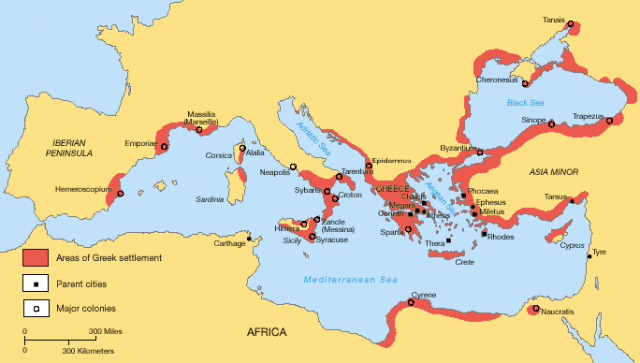Magna Graecia
MAGNA GRAECIA (or “Greater GREECE”) was the geographic expression of Greek colonization originating from many different Greek cities. It was a process that began in the 7th century B.C.E., largely because of overpopulation. Competing city-states such as Sparta, Corinth, and Athens began to found new cities (colonies) that, in turn, became centers of an economically thriving and internally competitive expansion of Greek culture. These new colonies were concentrated south from the Bay of Naples to the Gulf of Taranto and along the southern and eastern coasts of Sicily in the MEDITERRANEAN SEA. Because these colonies remained closely linked to their home cities in Greece proper, they together were known as Magna Graecia.

Despite the existence of earlier trading colonies established by the Phoenicians, Greek mythology and folklore eventually asserted the greatest influence on Sicily. In the 7th, 8th, and 9th centuries B.C.E., Sicily and the southern part of the Italian peninsula (today the poorest areas in ITALY) were colonized by Greeks, and it is claimed that the area boasted more Greeks and Greek temples than homeland Greece itself. This process dispersed Greek culture and arts throughout the central and western Mediterranean.
EARLY CONTACTS
Unlike Greek Sicily, Magna Graecia on the Italian peninsula began to decline by 500 B.C.E., probably because of malaria and endless warfare among the colonies, but certainly with the onslaught and emergence of the Roman Empire. Culturally, Magna Graecia also was the center of two philosophical groups in the 6th century B.C.E., Parmenides, who was at Elea, and Pythagoras (originally from Samos), who resided at Croton. And it was through contacts and trade with Magna Graecia that the Etruscans and the Romans first came into early contact with Greek civilization, especially its pottery and the practice of minting coins.
The chief city colonies of Magna Graecia (and their home city) were Tarentum (colonized by Spartans); Heraclea (by people from Tarentum); Metapontum (settled by Achaeans); Sybaris (Achaean immigrants) and then known as Thurii (settled by Athenians who replaced earlier colonists from Sybaris); Paestum, or Posidonia (settled by people from Sybaris); Laos (also settled by people from Sybaris); Siris (migrants from Colophon); Caulonia (people from Crotona); Epizephyrian Locris (settlers from Locris); Hipponium (migrants from Epizephyrian Locris); Cumae (people from Chalcis); Rhegium (now Reggio de Calabria, settled by people from Chalcis); Neapolis (now Naples, earliest people came from Cumae); and Elea (migrants came from Phocaea in Ionia).
It is amazing to historians and geographers that Magna Graecia, once a center of immense wealth and culture geographically, was concentrated in what today many consider to be the poorest and most backward areas of Italy.